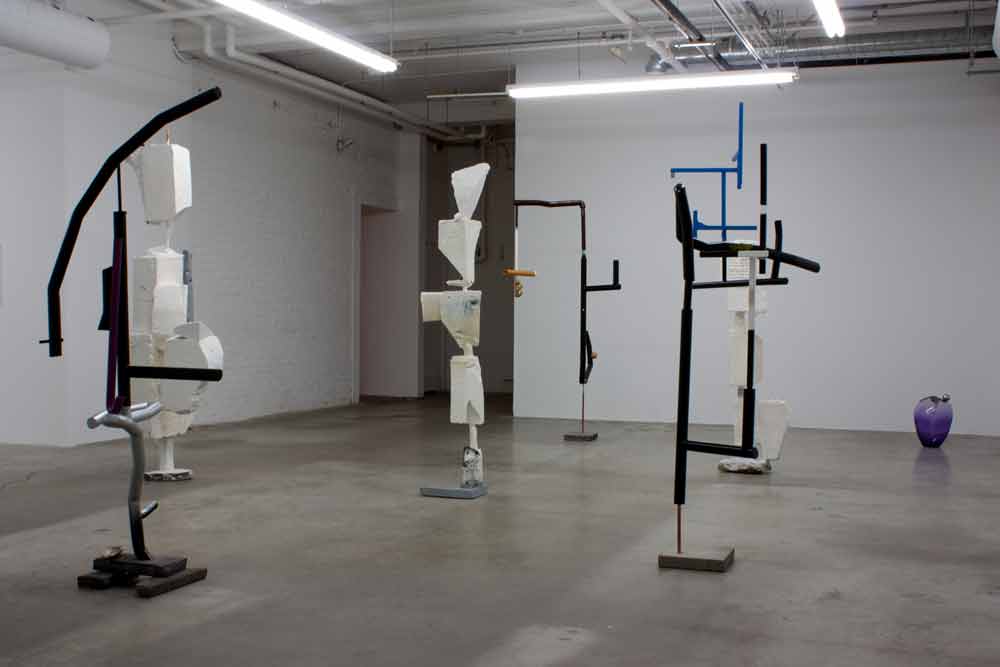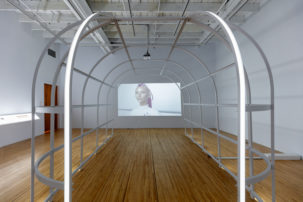When the works of two artists are displayed side by side, I can’t help but compare and contrast them. So it is with the Museum of Contemporary Canadian Art’s current shows on the late, revered French artist Louise Bourgeois and the 44-year-old Canadian artist David Armstrong Six. Each show features abstract-seeming sculptures that represent or refer to people, but each has a rather different effect.
In Bourgeois’s case, there are her Personages: tall, slim, carved wooden sculptures, made between 1946 and 1955, that would teeter over were they not anchored to the floor. In Armstrong Six’s case, there are sculptures in various materials (bronze, plaster, copper, wood, polytheylene mousse, glass, lead, etc.) that are titled after occupations or roles—The Janitor, The Mole, The Amateur, and so on. These were made while Armstrong Six was on a Berlin residency in 2012.
Though these sculptures seem formally alike in their verticality and references to figuration, their emotional resonance differs—particularly given their framing devices and accompanying wall works.
Bourgeois stated often that she was driven by a sense of emotional and psychological urgency, and a wall text indicates that the artist considered Personages to have grown out of immobility, stillness and fear, as well as a longing for faraway friends and family. The Personages are sensitively lit, the walls painted a warm brownish-greenish hue. Early, abstract drawings in black ink evoke twisting textiles, while later, figurative ones in red gouache show a blurry, bulbous body. The drawings, like most of the sculptures in the show, suggest a felt, handmade or embodied process, and they are accompanied by quote from Bourgeois in which she poetically calls drawings “thought feathers”: “They are ideas that I seize in mid-flight,” she stated, “and put down on paper.”
The Armstrong Six wall text, in contrast, makes little mention of the field of emotion that Bourgeois once said she was “prisoner” to. Instead, it refers to Armstrong Six as drawing on the tradition of Cubism, Surrealism and other Modernist artistic precedents, and as offering a kind of mashup of Minimalism and abjection. The space is lit with uniform fluorescent light and painted white. His pristine, methodical photographs document the sculptures in the show, sometimes with multiple views. The sense I got was of analysis, dissociation and a cool, intellectual remove.
The contrasts got me thinking not just about different artists, but different eras. A few months ago, young Canadian artist Jimmy Limit also paired photography with sculpture at Clint Roenisch. I wondered if this strategy reflects a contemporary phenomenon of consuming images as something “after the fact”—as documentation of life—rather than a past phenomenon of creating images as something “before the fact”—as generation of life, or at least objects in life. Bourgeois’s Personages might be read as her drawings come to life. How much could the same be said of Armstrong Six’s work? Or work by similar artists today? And what might that mean?
The MOCCA shows also provide an opportunity to consider how a single artist might change through time. The inclusion of Bourgeois’s impressive Cell (The Last Climb) is a case in point. After years of generating very painful and haunting Cell works—massive sculptures that take the shape and form of a room—this work, still painful but more resolved, completed the series in 2008, just a couple of years prior to Bourgeois’s death at the age of 98. In it, glass balls, a winding steel staircase and spools of thread are connected in a way that seems more at peace with the tears that haunted Bourgeois through her lifetime—as well as at peace with the idea of leaving that life behind altogether. It is a large work, a work that takes up space, something her Personages, when taken individually, seem downright scared to do.
Of course, in any exhibition experience, there are pairings or narratives that curatorial intent cannot predetermine. I laughed out loud when I saw a real-life spider crawling around on one of Armstrong Six’s sculptures near the end of my visit. The spider, of course, is one of Louise Bourgeois’s favoured subjects, a tiny subject she has famously writ large in massive sculptural form. In the documentary The Spider, the Mistress and the Tangerine, which I watched on iTunes after seeing the show, Bourgeois explains that the spider represents her mother: something reliable, logical and intellectual, as opposed to the passionate and unreliable tempest that was her father, who she in many ways took after.
At MOCCA, that miniscule, organic, entirely un-milled spider stretched its front legs in the air, feeling for reference points, before jumping off to an object nearby. It likely seemed a far jump to the spider—an entirely different place—but it was actually part of the same sculpture it had been standing on before. Watching the creature move at what scale it was limited to, jumping from point to point on a wider structure beyond its comprehension, I felt a few similarities between us, too.









